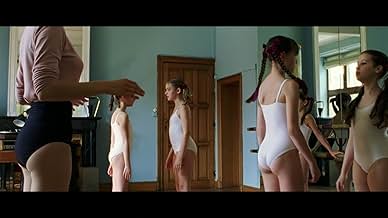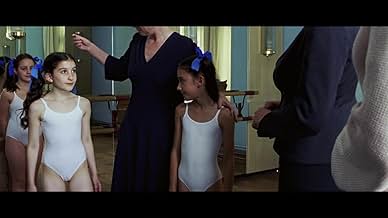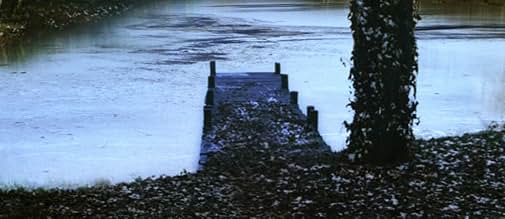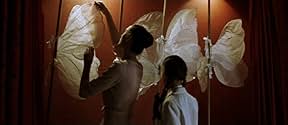Innocence
- 2004
- Tous publics
- 2h 2m
IMDb RATING
6.8/10
6.8K
YOUR RATING
A look inside an offbeat boarding school for young girls.A look inside an offbeat boarding school for young girls.A look inside an offbeat boarding school for young girls.
- Director
- Writers
- Stars
- Awards
- 8 wins & 2 nominations total
- Director
- Writers
- All cast & crew
- Production, box office & more at IMDbPro
Featured reviews
There can't be many films that occupy your mind for many days afterwards, make you read the book they are based on, and then watch them again.
"Innocence" is one of those films and it is both beautiful and intriguing at the same time. It is based on a book by Frank Wedekind called "Mine-Haha or the corporeal education of girls", the only published fragment of his unfinished novel "Hildalla". It was first published in 1901 and although beautifully written it has much darker undertones than the film with references to a body cult of youth and natural beauty which would later become exploited by Nazi culture.
The film is very much a metaphor for a childhood world which is in many ways separate but also protected from that of adults. It plays in an isolated Girls School their children enter at the time when they start to make their own independent experiences of the world around them and ends with the onset of puberty and attainment of menarche, both symbolising the emotional and physical end of childhood. The cinematography is beautiful and reminded me in many ways of Tarkovsky with its symbolism and haunting images. However, the story can seem a little simplistic and linear times and often appears to demand more depth from the young child actors than they could possibly deliver.
Nevertheless this is a very interesting and thought-provoking film and well worth watching. The French dialogue often has a musical quality and as long as you're prepared to watch this in a calm and unhurried state of mind this is very rewarding and unusual cinematic experience.
"Innocence" is one of those films and it is both beautiful and intriguing at the same time. It is based on a book by Frank Wedekind called "Mine-Haha or the corporeal education of girls", the only published fragment of his unfinished novel "Hildalla". It was first published in 1901 and although beautifully written it has much darker undertones than the film with references to a body cult of youth and natural beauty which would later become exploited by Nazi culture.
The film is very much a metaphor for a childhood world which is in many ways separate but also protected from that of adults. It plays in an isolated Girls School their children enter at the time when they start to make their own independent experiences of the world around them and ends with the onset of puberty and attainment of menarche, both symbolising the emotional and physical end of childhood. The cinematography is beautiful and reminded me in many ways of Tarkovsky with its symbolism and haunting images. However, the story can seem a little simplistic and linear times and often appears to demand more depth from the young child actors than they could possibly deliver.
Nevertheless this is a very interesting and thought-provoking film and well worth watching. The French dialogue often has a musical quality and as long as you're prepared to watch this in a calm and unhurried state of mind this is very rewarding and unusual cinematic experience.
We watched this film during my Film History and Theory class this past Thursday and aside from shoddy presentation (the projector was absolutely horrible and displayed the film too dark), I have to say that I enjoyed this quite a bit. At first, I almost dismissed it as artsy, pretentious French cinema due to the very slow pace and methodical direction but it had this eerie quality to it that kept my eyes glued to the screen, anticipating what was yet to come. The story is told in a very abstract way and the story is never really laid out for you in a conventional manner. In truth, it is a very simple tale but told in an imaginative way. There was great imagery and the use of sound to create a mysterious environment was very well done. At times it reminded me of the films of David Lynch, (especially Lost Highway and Mulholland Dr.) and Gaspar Noe (Irreversible), which is probably why I enjoyed it so much. The acting by the principals is very good, considering that they consisted mainly of very young girls. The director managed to capture natural performances from all of them and having worked with children on films in the past, I have to applaud her efforts on this end as I know how difficult it can be to get them to give you the results you're looking for. From a negative stance, the film runs just a bit too long and the pacing could've been trimmed a little to make it run a bit faster and leaner. There were stretches where the film felt like it was never going to end. In the end, I would definitely recommend this to those who appreciate art-house cinema as this caters directly to them. This was an impressive debut for Ms. Hadzihalilovic and I am definitely curious to see what she comes up with next.
RATING: ***1/2 out of *****.
RATING: ***1/2 out of *****.
If you've ever read the work of German symbolist writer Frank Wedekind then you may already have an idea about how difficult a text first feature writer-director Lucile Hadzihalilovic chose to adapt and execute. But execute she does for a good portion of the film until the rather obvious over-the-top conclusion that fails to answer many of the questions raised earlier.
That said, there is much to enjoy this film mainly due to its excellent cinemascope photography and the whole idea of an idyllic place where prepubescent girls are trained to be ballet dancers in order to enter the world as proper teenage women.
Since this is a symbolist writing, one can also entertain thoughts of purgatory (the characters are brought into being via a coffin), isolated same-sex societies (with one old man that is never explained), or some of the themes M. Night Shymalan explored in "The Village" with fear being used to keep a small population under control.
In any case, this film will provoke much discussion afterwards so bring your most knowledgeable cinema pals and dig in. Young girls in white outfits giggling and playing for two hours may not be everyone's simplification of the world at large, but in some ways it does sum up the dangers of segregated societies.
Not bad for a first film with extremely difficult material. A remarkable debut nonetheless.
That said, there is much to enjoy this film mainly due to its excellent cinemascope photography and the whole idea of an idyllic place where prepubescent girls are trained to be ballet dancers in order to enter the world as proper teenage women.
Since this is a symbolist writing, one can also entertain thoughts of purgatory (the characters are brought into being via a coffin), isolated same-sex societies (with one old man that is never explained), or some of the themes M. Night Shymalan explored in "The Village" with fear being used to keep a small population under control.
In any case, this film will provoke much discussion afterwards so bring your most knowledgeable cinema pals and dig in. Young girls in white outfits giggling and playing for two hours may not be everyone's simplification of the world at large, but in some ways it does sum up the dangers of segregated societies.
Not bad for a first film with extremely difficult material. A remarkable debut nonetheless.
Reading a lot of the interesting comments people have made about this film, it's obvious most didn't understand it.I admit this includes me. I enjoy an original idea for a movie, one that makes you think, but if it is too obscure surely that defeats the object? A lot of the comments mention paedophiles, an overused word that's fashionable at the moment.I'm a bloke but ye Gods, these were tiny little girls and not sexual. Someone mentioned the bathing and said they were uncomfortable with it. Nobody was nude! If a scene such as this makes a person less than happy, I suggest it says a lot about that person's mind. David Hamilton's 'Bilitis' has a scene where a group of schoolgirls strip off and go gamboling in the sea, that is certainly done, (in my view) to titillate. Innocence isn't at all like that. Europeans such as the French and Germans have, it seems to me, a lot healthier attitude to sex than either the Brits' or the US who tend to look for an ulterior motive in anything. Having said that- There is an interview with director Lucile Hadzihalilovic on the DVD, in it she mentions words to describe the movie, such as paradise, prison, nature, appealing and interesting.She says the film is essentially sensual and a claustrophobic universe. Also says that there is no violence and nothing offensive in it. It interested me to hear her say that women would identify with it easier than men, as their own view of young girls will be evoked. For some that may be problematic, for others, not at all. Read in that what you will chaps. There are few sights more pleasurable than a happy female, (of any age.) I remember an old saying, - 'Little girls, like butterflies, need no excuse.'
I walked out of this film being the only one of a group of 5 with any clasp of what it was about. That in itself may say something about my own innocence. Many reviews of this film seem to shout 'Paedophiles!' at the reader, to me this is an interesting reaction to a film, with near fairy tale qualities, which explores themes of innocence,childhood and how our own curiosity can destroy these. Every theme in this seemingly idyllic (and beautifully captured) girls school will represent a reason for one viewers loss of innocence, and when the film drags in places I do wonder if this intentionally mirrors a child's own impatience to 'grow up'. Perhaps it is the viewers lack of innocence that adds to the films underlying eeriness..........or perhaps its that rumbling noise?
Did you know
- TriviaIn the 'extras' on the DVD release, the director relates that children playing unsupervised in nature (the forest, the pond) is a 'freeing' setting for them, an 'uncontrolled' environment to explore. Water is very important, as it is a highly visible medium in its many forms (including within or from underneath a surface), and it is necessary, sensual, and enjoyable, but also dangerous (the drowning), and evokes many emotions. Flowing water can also symbolize the passage of time. The dynamic of children relating to adults, not understating them or their actions, while seeing them as role models, is another dichotomy the director wanted to emphasize. Ambiguity and a 'dream-like' quality are also important elements of the film. She states they digitally enhanced or 'tweaked' colors in the film to 'non-realistic' tones, to achieve mood and lighting effect, particularly day for night shots. The director says she is not interested in explaining meaning: "... what I like in cinema is being lost. I like films I don't completely understand, so they stay with me longer after they're over," and, "I believe everyone can find their own stories within the film."
- GoofsWhen Bianca says goodbye to all the girls there is snow in the alley and they are all outside dressed with bare arms and bare legs. Then Bianca runs away in pouring rain. No more snow on the ground.
- Crazy creditsThe entire set of credits is shown at the opening of the movie.
- ConnectionsFeatured in Women Make Film: A New Road Movie Through Cinema (2018)
- SoundtracksOrchestral Suite from La Petite Renard Rusée
Composed by Leos Janácek
Libretto by Rudolf Tesnohlídek
Performed by Czech Philharmonic (as The Czech Philharmonic)
Conducted by Vaclav Talich
- How long is Innocence?Powered by Alexa
Details
- Runtime2 hours 2 minutes
- Color
- Sound mix
- Aspect ratio
- 2.35 : 1
Contribute to this page
Suggest an edit or add missing content
























